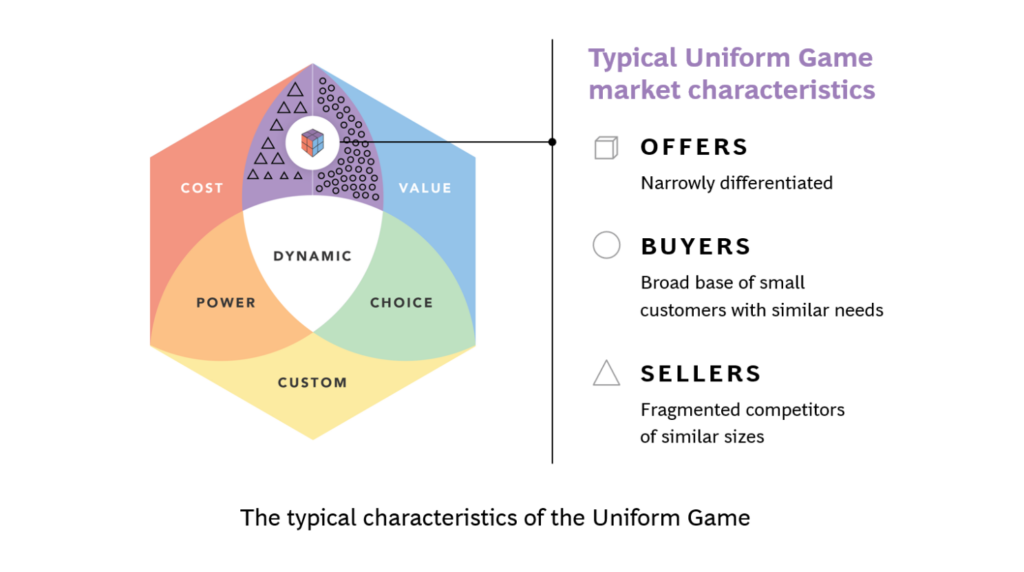Imagine how frustrating day-to-day shopping would be if you had to haggle over every single purchase instead of paying what’s on the price tag or the price list. For the last 150 years, uniform prices have made commerce more efficient for consumers and businesses, because they often foster a sense of fairness and make prices easy to compare.
The simplicity and clarity of uniform prices make sense for players of Value Game, as we discussed in the last newsletter. But they also make sense when differentiation among competitors is minimal and the needs of a vast pool customers are recurring, steady, and homogenous. That latter situation describes the Uniform Game, as the figure below elaborates.

The Uniform Game is one of the seven distinct pricing games of the Strategic Pricing Hexagon that we introduced in the first edition of our Game Changer newsletter. Players of the Uniform Game – such as consumer goods companies and retailers – win when they optimize the same prices for all customers by carefully weighing the tradeoffs between volume and margin.
The offers in the Uniform Game usually have only slight differentiation at best and meet the consistent, regular, and well-established needs of consumers. The economist Alfred Marshall, the father of the concept of price elasticity, recognized this precondition in his book Principles of Economics, when he wrote that “there are many classes of things the need for which on the part of any individual is inconstant, fitful, and irregular. There can be no list of individual demand prices for wedding-cakes, or the services of an expert surgeon.”
But within supermarkets, high-traffic shops, and mass printed catalogues – which all have non-negotiable (fixed) prices offered to all potential or eligible buyers – the Uniform Game predominates because many sellers of roughly the same size and influence are selling products or services with of similar value.
Price sensitivity is the critical insight
The price elasticity framework is the best approach for making efficient and confident pricing decisions in the Uniform Game. It helps business leaders estimate a demand curve by quantifying how sensitive customers are to price changes. Prices in the Uniform Game tend to sit within a narrow range dictated by a product’s elasticity and its costs. Companies set and change prices by using everyday, promoted, and cross elasticities to model the impact of potential price changes. The more granular the measurements, the more precise the price setting can be.
The very large number of relatively homogeneous buyers makes price elasticity estimates meaningful and valid. When combined with cost information, these estimates help leaders estimate a profit curve and thus understand the financial implications of any price changes.
Differentiation still matters
Winning the Uniform Game, however, depends on more than the ability to draw and interpret demand and profit curves. Recall that a pricing strategy is a company’s set of decisions on how much money is available in a market, how that money flows, and to whom. Companies can influence the shapes of demand and profit curves by influencing the price sensitivity of customers. Price sensitivity tends to decline if a company can stress value arguments, create a trusted brand, or carve out some level of differentiation. Higher brand equity and higher relative market share also tend to decrease price sensitivity.
Players of the Uniform Game have other ways to differentiate themselves. They can share more value with consumers on key value items (KVIs) or establish pricing zones defined by geography or channel. A smarter retail promotion strategy can play a critical role in a retailers’ overall strategy by helping them effectively communicate their value proposition and shape consumer perceptions. Personalized promotions, supported by the right tools, can also pave the way for a company to shift from the Uniform Game to the Dynamic Game within the Strategic Pricing Hexagon.
View this edition of The Game Changer Newsletter on LinkedIn

